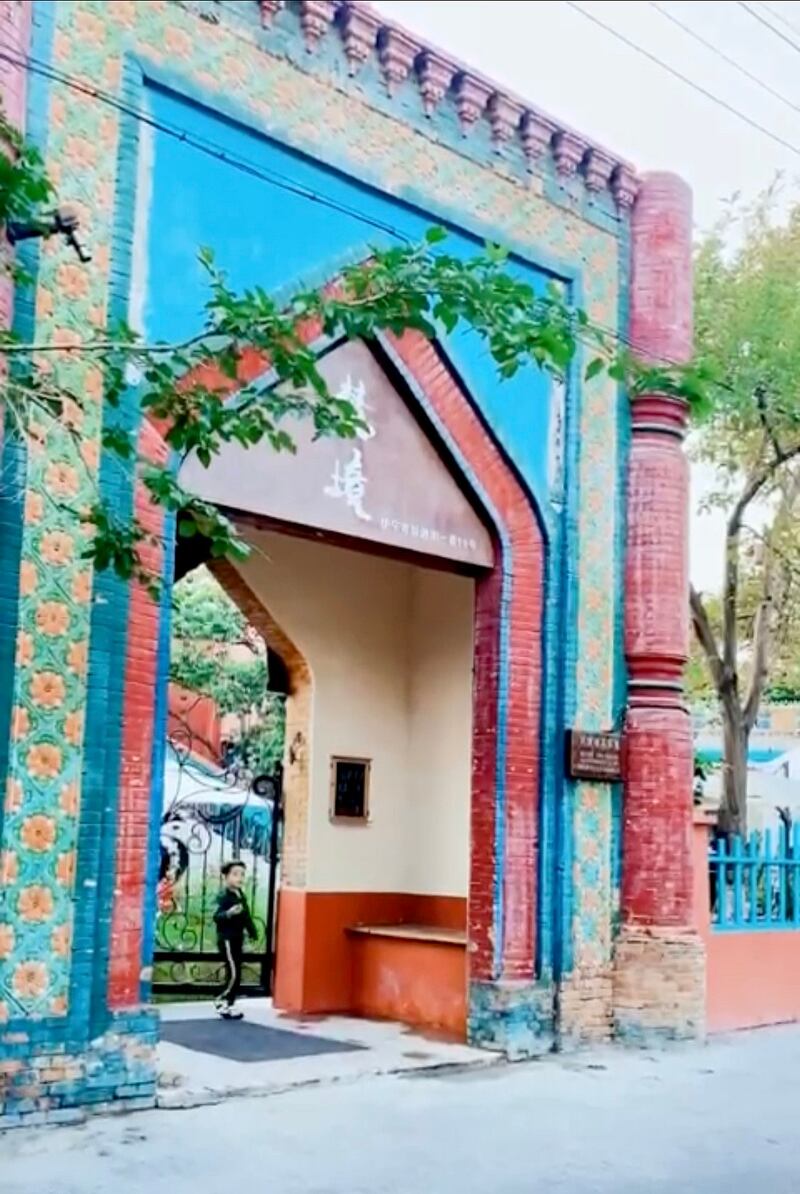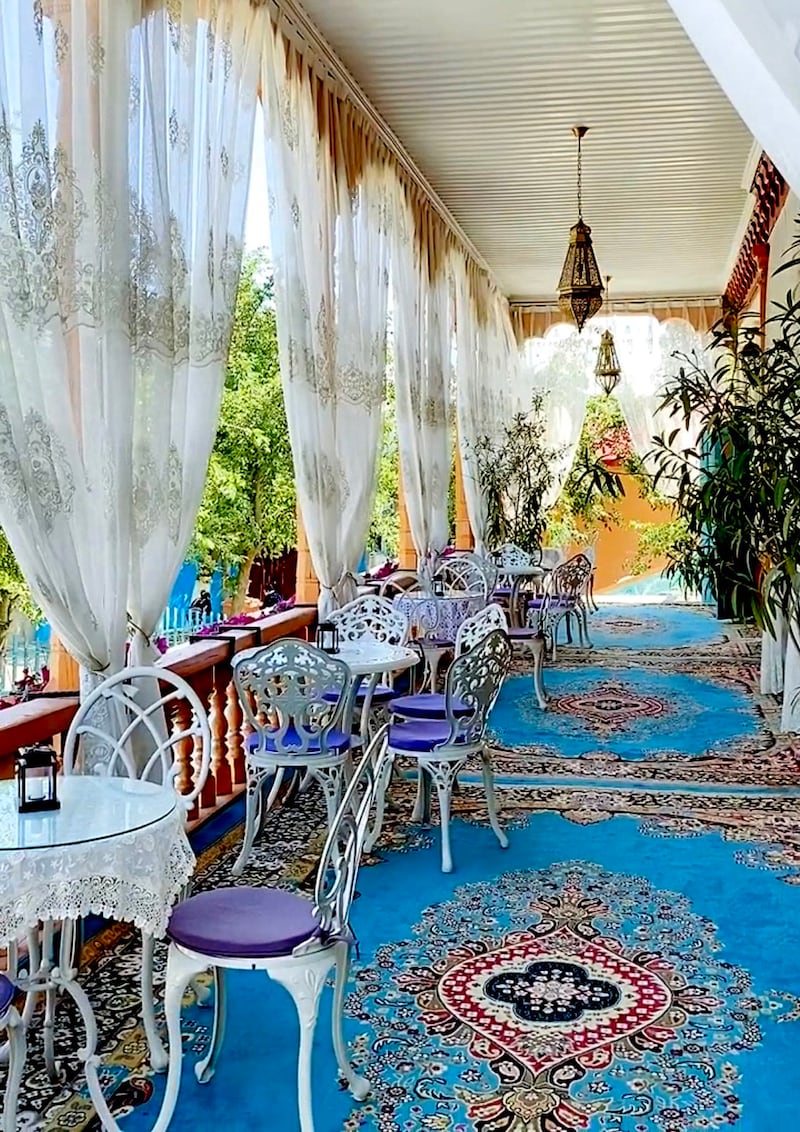Authorities in northwestern China’s Xinjiang Uyghur Autonomous Region (XUAR) have leased a mosque in Ghulja (in Chinese, Yining) city to a Han Chinese businessman from the capital Beijing, who turned the place of worship into a tourist hotel, according to sources.
Recently, video and photos depicting Han Chinese tourists drinking tea in the courtyard of a mosque decorated in the Uyghur style and dancing Uyghur-style folk dances along with ethnic Uyghur dancers in the mosque’s prayer hall spread among Uyghur diaspora users of Facebook and Twitter, where they caused an uproar.
Zumrat Dawut, a former detainee in one of the XUAR’s vast network of internment camps, where authorities are believed to have held up to 1.8 million Uyghurs and other Muslim minorities since early 2017, told RFA’s Uyghur Service that she had posted a video of the situation to Facebook after receiving it from a China-based source and confirming that the location was indeed a mosque.
“It’s the Uzbek Mosque in Ghulja. I just looked at the architecture inside the mosque and I knew,” said the Virginia-based activist, who regularly locates and disseminates video and photographic evidence of abuses in the XUAR to social media.
“From the pillars and the carpets inside, to the place where the imams sit, looking at the [images] I could see it was a mosque. And in addition to that, the Chinese person who took the video and uploaded it geo-tagged it, [showing that] it’s now been changed into a ‘cultural site.’”
RFA’s investigation into Dawut’s claims found that a mosque near the Chinese bazaar in Ghulja had been leased to a Han businessman from Beijing in 2019 and turned into a hotel that serves as both a tourist site and wedding venue known as the “Fanjing,” or scenic courtyard, hotel.
An online advertisement refers to the hotel as a high-end facility located in Ghulja’s newly established Qazanchi Tourist District. The advertisement notes that the architecture of the hotel combines European and Uyghur styles and that its facilities include a three-story eaved building, events hall, and flower garden in the courtyard, in addition to nine guest rooms. It claims that the hotel has been highly rated by guests and is a “popular spot for young people taking wedding photos.”
According to the local state-run Ghulja Daily, the hotel has been operating since 2020 and is owned by a Beijing travel company known as Gu Ying.
RFA’s Uyghur Service called a contact number for Gu Ying’s offices which was found on the online advertisement for the Fanjing Hotel and spoke with an employee who claimed that the hotel does not have telephone service and rooms can only be booked online.
She confirmed that the facility has grounds on which couples can take photos, and said the hotel opened in 2020.
“But if you’re a foreigner you can’t stay here,” she said, before adding that she could not answer questions about whether the hotel was formerly a mosque because the caller was based in the U.S.

Former Uzbek mosque of Ghulja
According to comments from diaspora members on Facebook, the mosque that was converted into the Fanjing Hotel was likely the former Uzbek mosque of Ghulja.
A woman who immigrated from Ghulja to Australia, and requested anonymity fearing reprisal, noted that her older sister previously lived near the Chinese market in Ghulja. The city’s No. 5 Intermediate School, was nearby; next to the school was a mosque known locally as the “Uzbek Mosque,” she said.
A Uyghur in the U.S., who gave only his first name, Jawdat, also suggested that the hotel is likely the Uzbek Mosque near the Chinese bazaar in Ghulja. In a telephone interview, Jawdat told us that his former home in Ghulja was located on the same street as the mosque, and that he prayed there on numerous occasions until he moved abroad in 2006.
“It’s an older-style mosque built by Uyghurs ... I don’t know when the mosque was closed. It was 2006 when I last prayed there,” he said, calling it “a well-built” place of worship.
Another U.S.-based Uyghur, who gave his name as Dilshat, said he had prayed at the mosque on his last visit to Ghulja in 2016. He said that the mosque—one of the oldest in Ghulja—had been incorporated into the No. 5 High School as a gymnasium during the Cultural Revolution in the 1970s but restored in the 1980s thanks to advocacy by the city’s community of Uzbeks, a Turkic ethnic group that number about 15,000 in China.
"Later, it ended up with a beautiful minaret, from which they would recite the azan [call to prayer], or play the naghra [a type of drum] at holidays and festivals. It had such a beautiful minaret. But then they tore it down again later," he said.
Dilshat said that while he was unaware of the fate of the Uzbek Mosque, many of Ghulja’s mosques had been demolished since 2017.

Mosques targeted
In October last year, Japan’s Asahi Shimbun reported that several mosques in both the XUAR’s capital Urumqi and Kashgar (Kashi) city had been turned into a restaurant for tourists.
The report cited a Han operator of a mosque-turned-cafe as saying that the space was being rented from the local government. Mosques in the XUAR are mostly owned and managed by the local government and rented out for other purposes once they are closed.
A September report by the Australian Strategic Policy Institute (ASPI) found that, since 2017, some 65 percent of the 533 mosques it sampled in satellite imagery had been either demolished or reconstructed for other purposes.
In August last year, RFA reported that a public toilet had been erected on the site of a demolished mosque in the XUAR’s Atush (Atushi) city, as part of what some observers believe is a campaign aimed at breaking the spirit of Uyghur Muslims.
Reports of the construction of the restroom on the former site of the Tokul mosque in Atush’s Suntagh village came days after RFA learned that authorities had razed two of three mosques there in carrying out a directive to destroy Muslim places of worship en masse that was launched in late 2016, known as “Mosque Rectification.”
Through early investigations into the Mosque Rectification campaign, RFA found that authorities had destroyed some 70 percent of the mosques across the XUAR. At the time, authorities gave “social safety” as the reason for the campaign, which appears to have continued into the years following 2016 and the intensification of the authorities' comprehensive repression of Uyghurs.
In addition to mosques, the Chinese authorities have been systematically destroying Muslim cemeteries and other religious structures and sites across the XUAR since 2016.
An investigation by Agence France-Presse revealed that at least 45 cemeteries in the XUAR had been destroyed from 2014 until last October, with 30 razed since 2017. The sites were turned into parks or parking lots or remained empty lots.
Reported by Mihray Abdilim for RFA’s Uyghur Service. Translated by the Uyghur Service. Written in English by Joshua Lipes.
